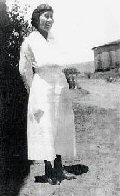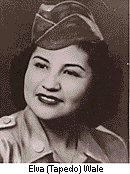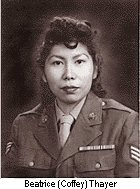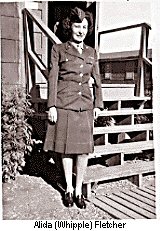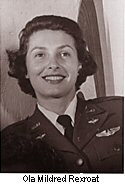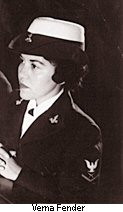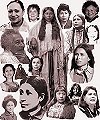 |
Ancient
Voices
A
Museum to honor the least known people in North America,
the Original Tribal Women |
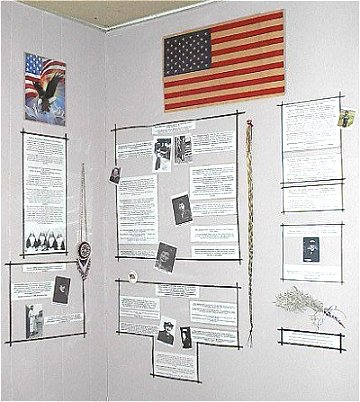
The
space in the actual museum dedicated to this section
Native American
Women in the Military
We all know about Lori Piestewa, the Hopi woman who was killed in action in Iraq, in fact I have a page dedicated to her on this site. However how many people know about the many American Indian woman who have been enlisted in the United States Military since the Spanish War? They have been both military personel and nursing staff in the various forces. This page will tell you about some of them.
I cannot take credit for the information on this page I have found it all on the Internet, and the credit for the various sites will be listed below the text. I must thank those who have done the legwork for me in this section, all credit goes to them. I just pulled it all together
The following article was written by: Judith Bellafaire, Ph.D., Curator
Women In Military Service For America Memorial Foundation, Inc.
Historians have only recently rediscovered and verified the actions of an Oneida woman, Tyonajanegen, at the battle of Oriskany during the American Revolution (1775-1783). Tyonajanegen was married to an American Army officer of Dutch descent. She fought at her husband's side on horseback during the battle, loading her husband's gun for him after he was shot in the wrist.
The story of Sacajawea, the Shoshone woman who accompanied the Lewis and Clark expedition of the early 19th century, is somewhat better known. Much of what is common knowledge is myth, however. Sacajawea has been remembered as a guide. In reality, she served as an interpreter for members of the expedition, who were unfamiliar with the Indian language. "Bird Woman's" service is described in the journals kept by Army Captains Meriwether Lewis and William Clark during the expedition.
Four Native American Catholic Sisters from Fort Berthold, South Dakota worked as nurses for the War Department during the Spanish American War (1898). They are shown here with their Chaplain, the Reverend Francis Craft. The four sisters are, left to right, Sister Josephine Two Bears, Sister Ella Clarke, Sister Bridget Pleets, and sister Anthony Bordeaux. Sister Bordeaux died in Cuba and was given a military funeral. Sister Bridget Pleets treasured to the end of her life the apron on which dying soldiers had written their names and addresses so that she could write to their relatives.
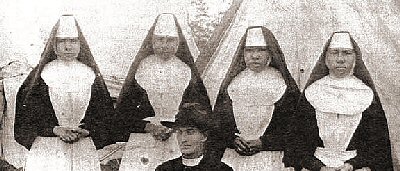
Picture courtesy of Pike County Historical Society
Fourteen Native American women served as members of the Army Nurse Corps during World War I, two of them overseas. |
Mrs. Cora E. Sinnard, a member of the Oneida Tribe and a graduate of the Episcopalian School of Nursing in Philadelphia, served eighteen months in France with a hospital unit provided by the Episcopal Church. |
|
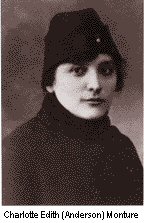 |
Charlotte Edith (Anderson) Monture of the Iroquois Nation also served as an Army nurse in France. Charlotte was born in 1890 in Ohsweken, Ontario, Canada. In 1917, she left her job as an elementary school nurse to join the Army Nurse Corps. She later referred to her service in France at a military hospital as "the adventure of a lifetime."
Charlotte passed away in 1996, at the age of 106.
|
Nearly 800 Native American women served in the military during World War II.
In 1943, Gailya and Thelma Barton, Cherokee sisters, were WAAC's who served with the Aircraft Warning Service. |
Elva (Tapedo) Wale, a Kiowa, left her Oklahoma reservation to join theWomen's Army Corps. Private Tapedo became an "Air WAC," and worked on Army Air Bases across the United States. Corporal Bernice (Firstshoot) Bailey of Lodge Pole, Montana, joined the Women's Army Corps in 1945 and served until 1948. After the war, she was sent to Wiesbaden, Germany, as part of the Army of Occupation. |
|
|
Beatrice (Coffey) Thayer also served in the Army of Occupation in Germany. Beatrice remembers being assigned to KP with German POWs, who were accompanied by armed guards.
Beatrice was in Germany when the Berlin Wall went up, and remained in the Army until the 1970s.
|
Pvt. Thomasita Chavez, San Juan Pueblo, was a field musician in the Marine Corps during WW ll |
Grace Thorpe, daughter of the famous athlete Jim Thorpe, was a WAC during WW ll. |
Corporal Lillian Lincheze, Navajo, served as a WAC recruiter during WW ll in Gallup, New Mexico. |
PFC. Blanche West, Chippewa, served as a WAC in England during WW ll. |
Lena Swearingen, Karuk, was an Army nurse who flew air evacuation. During this time medical air evacuation was a new specialty and these nurses were the pioneers |
Alida (Whipple) Fletcher joined the Army during World War II and trained as a medical specialist. She was assigned to the hospital at Camp Stoneman, California, which was an Army port of embarkation for the Pacific. Alida was on duty the night two ships loaded with explosives collided at a nearby ammunition dump, killing approximately 400 sailors and wounding many more.
The wounded were brought to the hospital where Alida worked. She remembers that night as the most tragic of her life.
|
|
First Lieutenant Julia (Nashanany) Reeves, a member of the Potawatomie Indian Tribe of Crandon, Wisconsin, joined the Army Nurse Corps in 1942, and was assigned to one of the first medical Units shipped to the Pacific.
The 52nd Evacuation Hospital Unit was sent to New Caledonia before its members had received their Army uniforms. When the hospital ship Solace arrived at New Caledonia, Julia was assigned temporary duty aboard the ship.
The following year, Julia was transferred to the 23rd Station Hospital in Norwich, England, where she was stationed during the invasion of Normandy. She remained in Norwich through V-J Day, returning shortly afterward to the United States.
During the Korean War, Julia mobilized with the 804th Station Hospital.
|
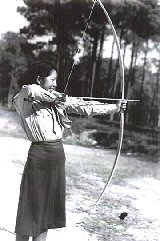 |
The first female American Indian to enroll in the Marine Corps Women's Reserve was Private Minnie Spotted-Wolf of Heart Butte, Montana,
She enlisted in the Marine Corps Women's Reserve in July 1943.
Minnie had worked on her father's ranch doing such chores as cutting fence posts, driving a two-ton truck, and breaking horses. Her comment on Marine boot camp "Hard but not too hard."
|
Ola Mildred Rexroat, an Oglala Sioux from Pine Ridge Indian Reservation, South Dakota, joined the Women's Airforce Service Pilots (WASP) directly out of high school. Her job was to tow targets for aerial gunnery students at Eagle Pass Army Air Base in Texas. Towing targets for student gunners was a fairly dangerous assignment, but "Rexy" was happy to be able to contribute to the war effort in a meaningful way.
After the war ended, Ola joined the Air Force and served for almost ten years.
|
|
Marcella Ryan Lebeau, Cheyenne River Sioux, served with the 76th General Hospital in Leige, Belgium. Her many memories include the daily buzz bomb attacks on the hospital. |
Evadna Diesel Muscavitch, Oneida, was with the 100th General Hospital in France. She remembers setting up pup tents in a cow pasture in the rain, water rationing and open air mess. |
Elsie Hogner, Cherokee, of Stillwell, Oklahoma, was assigned to the hospital at Camp Chaffee, Arkansas. She was a graduate of the University of Minnesota School of Nursing. |
Julia Nashanany Reeves, Forest County Potawotomi, was one of the women photographed for a 1942 “LIFE” article on the Army nurses on New Caledonia. |
Army nurse Viola Garcia Schneider, Catawba, cared for the survivors of the Bataan Death Camps while serving in Japan.
|
During the 1950s and 1960s, fewer women felt the call to military service. The services, however, were in desperate need of womanpower during the Korean conflict and the Vietnam War, and conducted extensive recruitment campaigns aimed at young women. Many Native American women answered their country's call.
Sarah Mae Peshlakai, a member of the Navajo Tribe from Crystal, New Mexico, enlisted in the Women's Army Corps in 1951 and served until 1957. Peshlakai trained as a medical specialist and was assigned to Yokohama Army Hospital in Japan, where she helped care for casualties from the Korean battlefields. |
Verna Fender entered the Navy during the Korean Conflict and trained at Bainbridge, Maryland. She was severely injured during basic training and was sent to a Navy hospital for physical rehabilitation. Undeterred, Verna returned to Bainbridge and completed her training.
The Navy assigned Verna to its base in San Diego, California, where she completed her 3-year term of enlistment, working in the departments of berthing and sectioning, supply, and ordnance.
|
|
Shirley M. Arviso, a Navajo of the Bitter Water Clan, served in the Navy from 1953 through 1963.
She was the Communications Officer in charge of a group of people who decrypted classified messages.
|
Linda Woods enlisted in the Air Force in the late 1950s and was on duty when President Kennedy was assassinated. She remembers that the air base where she was stationed went on full alert.
A later assignment took her to the southern United States during the Civil Rights movement. As a non-white, she found the environment somewhat difficult, however, she retained pride in her uniform as a woman of color.
|
Pearl Street Burks, Naticoke, served in the Women's Army Corps from 1962 - 1965 as a medical specialist. |
Patricia Curry, Seneca, was a Naval 2nd Class Petty Officer in Avionics during the Vietnam era. |
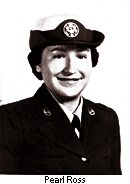 |
Pearl Ross, a member of the Arikara Tribe from the Fort Berthold Reservation, joined the Air Force in 1953, and trained as a medical specialist. Her first assignment was to the Air Force hospital in Cheyenne, Wyoming. Pearl was then assigned to Offutt Air Force Base in Nebraska, where she worked in the 865th Medical Group at SAC HQ. During theVietnam era, she saw many men who had been wounded in the combat theater. Pearl volunteered for overseas duty, but was turned down because the Air Force was hesitant to send women to Vietnam. |
Barbara Monteiro joined the WAC in 1963 and took her basic and secretarial training at Ft. McClellan. Alabama. Her first duty assignment was to Ft. Huachuca, Arizona, where she worked for three years in the travel office and motor pool in support of troop readiness during the Vietnam War. In 1966, Monteiro was assigned to Ft. Richardson, Alaska, where she served as an administration specialist at the Education Center for a year. |
Lance Corporal Valla Dee Jack Egge of Dougherty, Oklahoma, served in the U.S. Marine Corps in the early 1960s as the executive secretary to two commanding generals of the Parris Island Marine Corps Base, South Carolina. |
Anna Benton, of Bethel, Alaska, was the first Native Alaskan woman to enter the Armed Forces |
Increasing numbers of women, including Native Americans, entered the military in the 1970s and 1980s.
Patricia White Bear joined the Navy in 1981. She trained as an instrumentman and served at sea repairing, adjusting and calibrating the wide variety of mechanical measuring instruments used aboard ships. Dolores Kathleen Smith, a Cherokee, graduated from the Air Force Academy in 1982. She completed navigator training and was assigned to a KC-135 unit. She served in the operational plans division of her unit and also as an instructor before retiring as a captain from the Air Force in 1990.
|
Darlene Yellowcloud of the Lakota Tribe was inspired to join the Army because so many of the men in her family had served. Her grandfather, Bear Saves Life, was killed in action in France during World War I. Her father, brothers, brothers-in-law, uncles and cousins were all veterans. Darlene was assigned to the U. S. Army in Korea as a Specialist 4th Class. |
Lawnikwa Spotted-Eaglefortune joined the Army in 1988, and attended Basic Training at Fort Dix, New Jersey. Acting as a guide-on carrier, she was injured when another carrier grounded a guide iron through her foot into the ground. She still has the scar, and now serves as a member of the Virginia Air National Guard. |
Marilyn Kemp, Quinault, served as a clerk-typist from 1970-1973 in the Women's Army Corp. |
The first Indian woman to graduate from West Point was Brigitte Wahwassuck, Potawatomi. |
Native American women lost their lives in the service of their nation.
Terri Ann Hagen, a former Army medic, was a member of the Army National Guard when she was killed fighting a fire on Storm King Mountain in Colorado in 1994. |
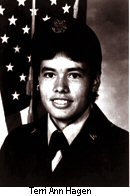 |
Katherine Matthews of Cherokee, North Carolina, joined the Navy in the late 1970s and trained as an Aviation Machinist's Mate.
She died while serving in California in 1985.
|
As of 1980, at least sixty Native American women were serving in the Eskimo Scouts, a special unit of the Alaska National Guard.
The Eskimo Scouts patrol the western coastline of Alaska and the islands separating Alaska and Russia. The Scouts are the only members of the National Guard who have a continuous active duty mission.
This unit was organized during World War II, and the wives of scout battalion members have always been involved in patrol missions.
Women were admitted as official members in 1976, and only then began to receive pay, benefits and recognition for their work.
Scouts currently patrol ice flows in the Bering Straits, monitor movements on the tundra, and perform Arctic search and rescue efforts as required.
|
As of 1994, 1,509 Native American women and Native Alaskan women were serving in the military forces of the United States. Thousands more have served in the military over time.
Currently there are Indian women serving aboard the aircraft carriers the USS Roosevelt and the USS Stennis.
The Women In Military Service For America Memorial Foundation is attempting to fill the gap of information of Native American woman in the various services by encouraging Native American women veterans to register with the Memorial so that their stories may be recorded and preserved. They are also conducting research on the contributions of Native American women of earlier eras.
|
Resources & Credits
http://www.library.wisc.edu/libraries/womensstudies/native.htm |
Brenda Finnicum Lieutenant Colonel, Army Nurse Corps Retired |
http://www.nativewomenveterans.org/circleofhonor1.htm |
http://home.att.net/~ferguspcj/bridge/bridge.htm bridge of wings |
|




